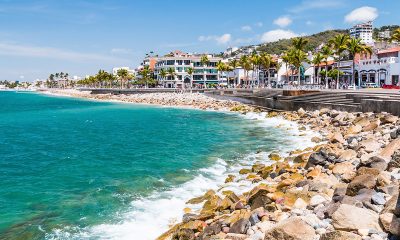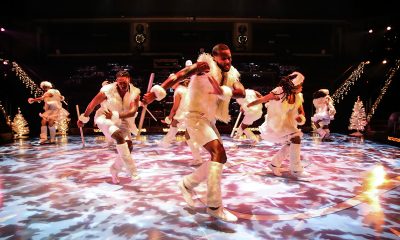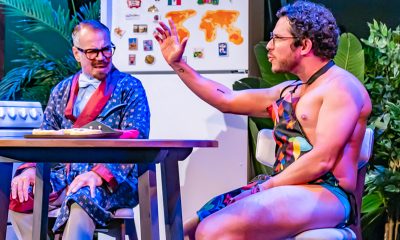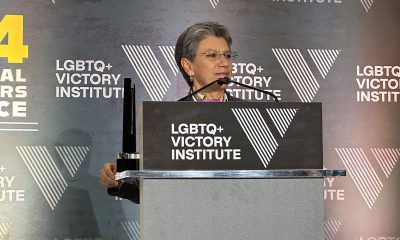a&e features
Rufus Wainwright on opera, revisiting his first two albums
Out singer/songwriter plays Strathmore this weekend on anniversary tour
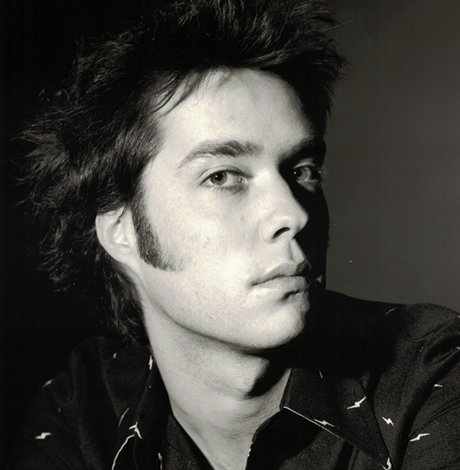
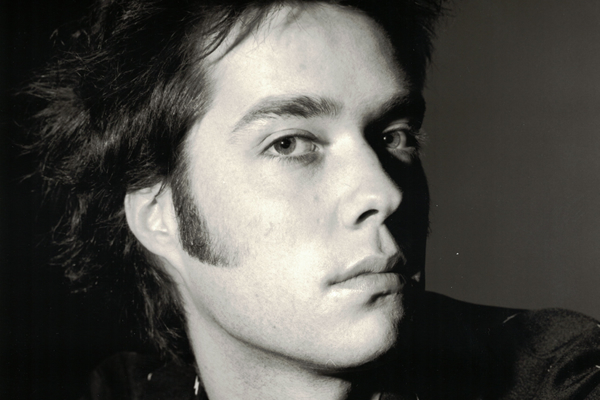
Singer/songwriter/composer Rufus Wainwright, seen here in a vintage outtake from the ‘Poses’ sessions, says launching an opera is a Herculean undertaking but one his artistic impulses required. (Photo by Greg Gorman)
Rufus Wainwright
All These Poses Anniversary Tour 2018
Saturday, Dec. 8
8 p.m.
Music Center at Strathmore
5301 Tuckerman Lane
North Bethesda, Md.
$39-89+VIP
Singer/songwriter Rufus Wainwright, 45, is on tour celebrating 20 years since his debut. He’s touring a revival of his first two albums and is fresh off the October premiere of his second opera, the gay-themed “Hadrian” about the Roman emperor of the title and his male lover Antinous. It launched with the Canadian Opera Company in Toronto. Wainwright spoke to the Blade by phone from Minnesota.
WASHINGTON BLADE: How is your tour going so far?
RUFUS WAINWRIGHT: It’s going great. It’s been pretty amazing actually. I’m really kicking myself in terms of just in wonder on how in God’s name I could have gotten such a great band together as well as writing an opera and being a father and stuff. … I’m really beyond satisfied with the band that we’ve brought out for the “Poses Tour.” It’s really, really fantastic.
BLADE: You do most of your (1998 eponymous) debut album but mix it up but then you do “Poses” (2001) straight through in its entirety. Why?
WAINWRIGHT: I think to just perform both albums back to back would have been a little too clinical for the audience. It’s a rather long evening and I wanted to mix it up in the sense that I’d be able to present some of my new projects like this Canadian album that I released called “Northern Stars,” so I do like one Joni Mitchell song to promote that then I have a new song “Sword of Damocles” that I wanted to sing so I wanted to have some freedom to be able to swim around a bit. But then in the second half we do “Poses” from top to bottom and that gives a really different character to the second half of the show.
BLADE: Pretty faithful arrangements?
WAINWRIGHT: Yeah, we’re trying to capture the original lines as best we can. We can’t get all the harmonies and we don’t have an orchestra of course, but otherwise it’s very faithful to the original.
BLADE: Sometimes something works great on a record at home but can feel very different in a live room. Any issues with that translation?
WAINWRIGHT: There doesn’t seem to be. What’s becoming evident to me is that my original strategy of writing songs that are impressive both to sing and to communicate a message, that’s at the heart of each piece. All the arrangements and harmonies and different mixes are really there to serve the song. That’s how I always felt in the studio and it’s still about that structure, even subconsciously, when I perform it in public.
BLADE: How was it performing at the Joni Mitchell 75th birthday tribute concerts a few weeks ago?
WAINWRIGHT: It was amazing. I was able to share the stage with some real legends of the industry be it Seal or Diana Krall or Emmylou Harris, all these amazing people. And then having Joni there the second night kind of beaming in the audience as we sang was a real honor and privilege.
BLADE: How did it work out that you sang “Blue”? Did you pick that or Joni?
WAINWRIGHT: Actually my husband chose that song. Nobody had taken it, I think mainly due to the height of its nature. I mean it’s an iconic piece and it’s so tied to Joni’s individualistic style that nobody really requested it so (event creator/Wainwright spouse) Jorn (Weisbrodt) sort of put it forth and said it would be a real challenge for you to do “Blue” and me being a man who loves to complicate his life you know, jumped at the chance.
BLADE: How is Joni? Is she able to walk and talk? (Mitchell had a brain aneurysm in 2015)
WAINWRIGHT: She walks with assistance and she talks. It’s not as fierce as it once was. I don’t in any way want to minimize what occurred to her medically and it’s not something I would wish on anyone but that being said, I do feel that there is essentially — I don’t know, she’s softened in a way, which you know with strokes the opposite can happen. You can become incredibly bitter and angry and just be in a worse place. I don’t feel from my perspective that that has occurred to her. I think she’s in a real place of acceptance, which is good to be in when you’re older.
BLADE: Did you know from the outset that Hadrian (the title character in Wainwright’s new opera) was a bottom?
WAINWRIGHT: (laughs) I’ve been wanting to write this opera for many, many years and ages ago I was speaking with someone and they brought up that concept and it really stuck with me. … So I’ve known for a long time that it would be a necessary kind of element to give the opera more depth. I’ve known for a long time.
BLADE: How was the Toronto production and were you there the whole time?
WAINWRIGHT: I was there most of the time it was really fabulous. I had some of the greatest singers on the planet performing the opera with Thomas Hampson and Karita Mattila and the others were incredible too but just in terms of stature, those two are second to none. So there was that and also the audience was incredible, it sold very well. There was always an enthusiastic reaction and I have no complaints whatsoever about the experience. Now trying to get a four-act grand opera presented in other opera houses of the world is itself another herculean task, especially in the world we live in now which isn’t really opera-centric, but I’m one who kind of enjoys a fight so here we go.
BLADE: What do you know now that you didn’t know after your first opera?
WAINWRIGHT: I learned a few things. One is that an artist really has to compose what they are called upon to compose, you know? After the premiere, I kind of looked back and kind of said, “Why in God’s name did I do that?” Only because it took so long and it was such a lot of work, it cost a lot of money and I don’t know what it has to do with today or anything like that. But I realized oh my God, I was really under a kind of spell and that’s really all that I could hold onto really as an artist and all I can kind of go with. And then the piece has to really fend for itself. So I just have to remind myself that I’m doing this because it’s meant to be even though it might seem crazy. And then also I realize that along the way so much of what I’ve learned I can then communicate in other areas of my artistic life. I’m looking forward to doing that. Just the craft that one learns in writing for an orchestra and working with opera singers is astounding and I’m excited to bring that into all my other work.
BLADE: Classical music critic David Patrick Stearns wrote last year about revisions made to a Barber opera after its 1966 premiere and said, “Even though the revisions made theatrical sense by cutting extraneous information, opera is not about information. Half the time you don’t know what an opera is truly telling you until you’ve lived with it a few decades.” Your thoughts?
WAINWRIGHT: When we premiered “Hadrian,” I had to cut out practically an hour for it to fit into the constraints of union rules with the theater. So in terms of editing and so forth, that definitely had to happen and now in moving forward for other theaters, I do want to do some revisions. I do feel that an opera is a kind of a living organism that needs upkeep. That being said though, yeah, it’s a gamble and yes, the game you’re playing with opera is the long game and all of that can only really be fully understood arguably sometimes a century later. That’s all I can say.
BLADE: “Hallelujah” (the Leonard Cohen song Wainwright covered) has really gotten overdone, almost to the point of “Imagine.” I lost count of how many skaters skated to it at the last Olympics. Are you tired of it?
WAINWRIGHT: I’ve had my ups and downs with that song for a long time. When I first performed it, it wasn’t something that I gravitated to. It was because it had become very popular from “Shrek” and that’s something I was just asked to do and did and didn’t have any emotional connection to. But then I started singing it and I started to resent it because that’s all I was known for and I actually made a concerted effort to squash that stream. But then I started to realize that I could just throw it into any situation and people were instantly on my side, so and then I became thankful for it. And then when Trump was up for election, I said I wouldn’t sing it if he won the election. It became that thing. So then he won and then I didn’t sing it and then Leonard Cohen died, so it kind of keeps coming back. I respect the song in a lot of ways. It’s not my favorite Leonard Cohen song by any means but one has to give it some credit in terms of its indomitable character that just keeps coming back and that is somewhat impressive. I owe a lot to that song as well in terms of having a real mainstream appeal. So I’m of two minds.
BLADE: Do you ever listen to your mom’s records or have a favorite?
WAINWRIGHT: I love my mom’s records, they’re great. I would probably say my personal favorite is “Dancer with Bruised Knees,” which is their second album. I have a slight bias on that one because there’s a song “First Born” that is sort of about me a little bit.
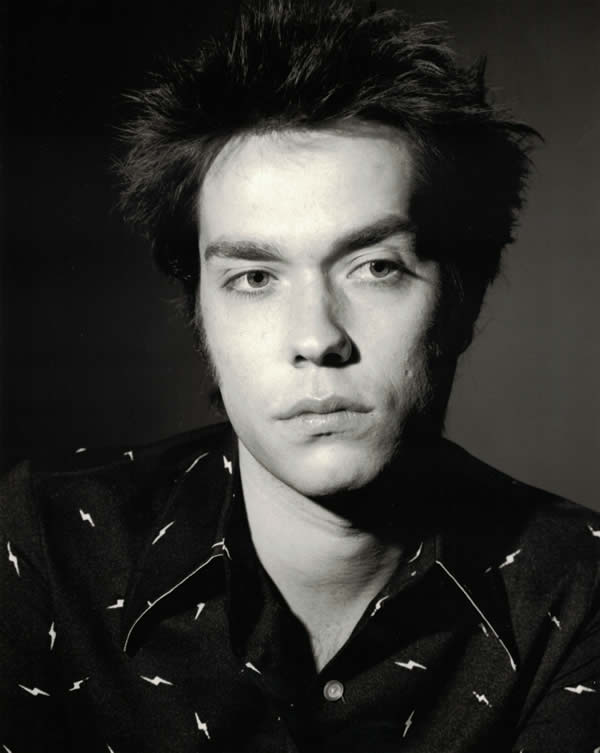
Rufus Wainwright, seen here in a vintage photo, has a soft spot for the music of his mother, Kate McGarrigle who performed as Kate & Anna McGarrigle with her sister. (Photo by Greg Gorman)
a&e features
Queer highlights of the 2026 Critics Choice Awards: Aunt Gladys, that ‘Heated Rivalry’ shoutout and more
Amy Madigan’s win in the supporting actress category puts her in serious contention to win the Oscar for ‘Weapons’

From Chelsea Handler shouting out Heated Rivalry in her opening monologue to Amy Madigan proving that horror performances can (and should) be taken seriously, the Critics Choice Awards provided plenty of iconic moments for queer movie fans to celebrate on the long road to Oscar night.
Handler kicked off the ceremony by recapping the biggest moments in pop culture last year, from Wicked: For Good to Sinners. She also made room to joke about the surprise hit TV sensation on everyone’s minds: “Shoutout to Heated Rivalry. Everyone loves it! Gay men love it, women love it, straight men who say they aren’t gay but work out at Equinox love it!”
The back-to-back wins for Jacob Elordi in Frankenstein and Amy Madigan in Weapons are notable, given the horror bias that awards voters typically have. Aunt Gladys instantly became a pop culture phenomenon within the LGBTQ+ community when Zach Cregger’s hit horror comedy released in August, but the thought that Madigan could be a serious awards contender for such a fun, out-there performance seemed improbable to most months ago. Now, considering the sheer amount of critics’ attention she’s received over the past month, there’s no denying she’s in the running for the Oscar.
“I really wasn’t expecting all of this because I thought people would like the movie, and I thought people would dig Gladys, but you love Gladys! I mean, it’s crazy,” Madigan said during her acceptance speech. “I get [sent] makeup tutorials and paintings. I even got one weird thing about how she’s a sex icon also, which I didn’t go too deep into that one.”
Over on the TV side, Rhea Seehorn won in the incredibly competitive best actress in a drama series category for her acclaimed performance as Carol in Pluribus, beating out the likes of Emmy winner Britt Lower for Severance, Carrie Coon for The White Lotus, and Bella Ramsey for The Last of Us. Pluribus, which was created by Breaking Bad’s showrunner Vince Gilligan, has been celebrated by audiences for its rich exploration of queer trauma and conversion therapy.
Jean Smart was Hack’s only win of the night, as Hannah Einbinder couldn’t repeat her Emmy victory in the supporting actress in a comedy series category against Janelle James, who nabbed a trophy for Abbott Elementary. Hacks lost the best comedy series award to The Studio, as it did at the Emmys in September. And in the limited series category, Erin Doherty repeated her Emmy success in supporting actress, joining in yet another Adolescence awards sweep.
As Oscar fans speculate on what these Critics Choice wins mean for future ceremonies, we have next week’s Golden Globes ceremony to look forward to on Jan. 11.
a&e features
Looking back at the 10 biggest A&E stories of 2025
‘Wicked,’ Lady Gaga’s new era, ‘Sexy’ Bailey and more

Although 2025 was a year marked by countless attacks on trans rights and political setbacks, the year also saw brilliant queer artists continuing to create art. From Cannes and Sundance Award winners now vying for Oscar consideration to pop icons entering new stages of their careers, queer people persevered to tell their stories through different media.
With the state of the world so uncertain, perhaps there’s no more vital time to celebrate our wins, as seen through some of this year’s top pop culture moments. While there’s no collection of 10 stories that fully encompass “the most important” news, here are some events that got the gays going:
10. ‘Mysterious Gaze of the Flamingo’ wins big at Cannes

The Cannes Film Festival has become a crucial start for films hoping to make their way to the Oscars, and first-time director Diego Céspedes won the top Un Certain Regard prize for his intimate western “The Mysterious Gaze of the Flamingo.” The film is set in the ‘80s and is intended as an allegory for the AIDS epidemic. Seeing a film that unpacks vital queer history win one of the most coveted awards at Cannes has been a huge point of pride in the independent filmmaking community.
Since the film bowed at Cannes, it has been selected as Chile’s Oscar entry in the Best International Feature race. Speaking with The Blade during the film’s AFI Fest run in October, Céspedes said: At first, I was kind of scared to have this campaign position in the times that we’re living [in] here. But at the same time, I think the Oscars mean a huge platform — a huge platform for art and politics.”
9. ‘The Last of Us’ returns for an even gayer season 2
While the first season of The Last of Us gave us one of TV’s most heartbreaking queer love stories in the episode “Long, Long Time,” Season 2 doubled down on its commitment to queer storytelling with the blossoming relationship between Ellie (Bella Ramsey) and Dina (Isabela Merced). The show expanded on the pair’s relationship in the original video game, making it perhaps the central dynamic to the entire season. That unfortunately came with more homophobic backlash on the internet, but those who checked out all the episodes saw a tender relationship form amid the show’s post-apocalyptic, often violent backdrop. For their performance, Ramsey was once again nominated for an Emmy, but Merced deserved just as much awards attention.
8. ‘Emilia Pérez’ sparks controversy
Jacques Audiard’s genre-bending trans musical “Emilia Pérez” proved to be an awards season juggernaut this time last year, winning the Golden Globe for Best Musical/Comedy. But when the lead star Karla Sofia Gascón’s racist, sexist, and homophobic old tweets resurfaced, the film’s Oscar campaign became a tough sell, especially after Netflix had tried so hard to sell Emilia Pérez as the “progressive” film to vote for. Mind you, the film had already received significant backlash from LGBTQ+ audiences and the Mexican community for its stereotypical and reductive portrayals, but the Gascón controversy made what was originally just social media backlash impossible to ignore. The only person who seemed to come out of the whole debacle unscathed was Zoe Saldaña, who won the Oscar for Best Supporting Actress over Ariana Grande.
7. ‘Sorry, Baby’ establishes Eva Victor as major talent
Back in January at the Sundance Film Festival, Eva Victor (known by many for her brand of sketch comedy) premiered their directorial debut “Sorry, Baby” to rave reviews, even winning the Waldo Salt Screening Award. Victor shadowed Jane Schoenbrun on the set of “I Saw the TV Glow,” and seeing Victor come into their own and establish such a strong voice immediately made them one of independent cinema’s most exciting new voices. A memorable scene in the film sees the main character, Agnes (played by Victor), struggling to check a box for male or female, just one example of how naturally queerness is woven into the fabric of the story.
Most recently, Victor was nominated for a Golden Globe for her performance in the film, and she’s represented in a category alongside Jennifer Lawrence (“Die My Love”), Jessie Buckley (“Hamnet”), Julia Roberts (“After the Hunt”), Renate Reinsve (“Sentimental Value”) and Tessa Thompson (“Hedda”). The film also received four Independent Spirit Award nominations overall.
6. Paul Reubens comes out in posthumous doc

While Paul Reubens never publicly came out as gay before passing away in 2023, the two-part documentary “Pee-wee as Himself” premiered back in May on HBO Max, giving the legendary comedian a chance to posthumously open up to the world. Directed by Matt Wolf, the documentary explores how Reubens found his alter ego Pee-Wee Herman and why he kept his private life private.
The documentary won an Emmy in the Outstanding Documentary or Nonfiction Special category and remains one of the most critically acclaimed titles of the year with a 100% Rotten Tomatoes score. Also worth noting, the National Geographic documentary Sally told the posthumous coming out story of Sally Ride through the help of her long-time partner, Tam O’Shaughnessy.
5. Lady Gaga releases ‘Mayhem’
Lady Gaga entered a new phase of her musical career with the release of Mayhem, her seventh album to date. From the frenzy-inducing pop hit Abracadabra to the memorable Bruno Mars duet featured on “Die With a Smile,” seeing Gaga return to her roots and make an album for the most die-hard of fans was especially rewarding after the underwhelming film releases of “House of Gucci” and “Joker: Folie à Deux.” Gaga has been touring with The Mayhem Ball since July, her first arena tour since 2018. She even extended her tour into 2026 with more North American dates, so the party isn’t stopping anytime soon. And Gaga is even set to make an appearance next May in “The Devil Wears Prada 2.”
4. Cynthia Erivo, Ariana Grande perform at the Oscars

While “Wicked: For Good” didn’t quite reach the heights of the first film, we will forever have Cynthia Erivo and Ariana Grande’s breathtaking live performance that opened the 97th Academy Awards. The pair sang a rendition of “Over the Rainbow,” “Home,” and “Defying Gravity,” paying proper homage to the original 1939 “Wizard of Oz.” Even non-Wicked fans can’t deny how magical and brilliantly staged this performance was. With both Erivo and Grande up for acting Oscars last year, they’re hoping to repeat success and make history with consecutive nominations. Either way, let’s hope there’s another live performance in the making, especially with two new original songs (The Girl in the Bubble and No Place Like Home) in the mix.
3. Indya Moore speaks out against Ryan Murphy
Indya Moore has consistently used social media as a platform for activism, and in September, posted a 30-minute Instagram live speaking out against “Pose” co-creator Ryan Murphy. Moore claimed that Murphy wasn’t being a true activist for trans people. “Ryan Murphy, we need you to do more. You need to address the racism, the violence, and the targeting of people on your productions, Ryan Murphy. You do need to make sure trans people are paid equally. Yes, Janet did the right thing,” Moore said. Murphy was also back in the headlines this year for the critically panned “All’s Fair” and the controversial “Monster: The Ed Gein Story” starring Laurie Metcalf and Charlie Hunnam.
2. Cole Escola wins Tony for Best Leading Actor
Few pop culture moments this year brought us together more than Cole Escola winning a Tony award for “Oh, Mary!” the Broadway show they created, wrote and starred in (we love a triple threat!) Escola made history by becoming the first nonbinary person to win a Tony in the leading actor category, and seeing them excitedly rush to the stage wearing a Bernadette Peters-inspired gown instantly became a viral social media moment.
The cherry on top of Escola’s major moment is the recent news that they are writing a Miss Piggy movie with Jennifer Lawrence and Emma Stone producing — news that also broke the internet for the better. We cannot wait!
1. Jonathan Bailey makes gay history as ‘Sexiest Man Alive’

The same year as his on-screen roles in blockbusters “Jurassic World Rebirth” and “Wicked: For Good,” Jonathan Bailey made history as the first openly gay man to be named People magazine’s “Sexiest Man Alive.” The fact that it took 40 years for an openly gay man to earn the title is a signifier of how far we still have to go with queer representation, and seeing Bailey celebrated is just one small step in the right direction.
“There’s so many people that want to do brilliant stuff who feel like they can’t,” he told PEOPLE, “and I know the LGBT sector is under immense threat at the moment. So it’s been amazing to meet people who have the expertise and see potential that I could have only dreamed of.” In 2024, Bailey founded the charity titled The Shameless Fund, which raises money for LGBTQ+ organizations.
a&e features
Your guide to D.C.’s queer New Year’s Eve parties
Ring in 2026 with drag, leather, Champagne, and more

With Christmas in the rear view mirror, we can turn our attention to ringing in a much-anticipated New Year with a slew of local LGBTQ parties. Here’s what’s on tap.
Pitchers
This spacious Adams Morgan bar is hosting the “Pitchers’ Perfect New Year’s Eve.” There will be a midnight Champagne toast, the ball drop on the big screens, and no cover, all night long. The bar doesn’t close until 4 a.m., and the kitchen will be open late (though not until close). All five floors will be open for the party, and party favors are promised.
Trade
D.C.’s hottest bar/club combo is leaning into the Shark motif with its NYE party, “Feeding Frenzy.” The party is a “glitterati-infused Naughty-cal New Year’s Even in the Shark Tank, where the boats are churning and the sharks are circling.” Trade also boasts no cover charge, with doors opening at 5 p.m. and the aforementioned Shark Tank opening at 9 p.m.. Four DJs will be spread across the two spaces; midnight hostess is played by Vagenesis and the two sea sirens sensuously calling are Anathema and Justin Williams.
Number Nine
While Trade will have two DJs as part of one party, Number Nine will host two separate parties, one on each floor. The first floor is classic Number Nine, a more casual-style event with the countdown on TVs and a Champagne midnight toast. There will be no cover and doors open at 5 p.m. Upstairs will be hosted by Capital Sapphics for its second annual NYE gathering. Tickets (about $50) include a midnight Champagne toast, curated drink menu, sapphic DJ set by Rijak, and tarot readings by Yooji.
Crush
Crush will kick off NYE with a free drag bingo at 8 p.m. for the early birds. Post-bingo, there will be a cover for the rest of the evening, featuring two DJs. The cover ($20 limited pre-sale that includes line skip until 11 p.m.; $25 at the door after 9 p.m.) includes one free N/A or Crush, a Champagne toast, and party favors (“the legal kind”). More details on Eventbrite.
Bunker
This subterranean lair is hosting a NYE party entitled “Frosted & Fur: Aspen After Dark New Year’s Eve Celebration.” Arriety from Rupaul Season 15 is set to host, with International DJ Alex Lo. Doors open at 9 p.m. and close at 3 p.m.; there is a midnight Champagne toast. Cover is $25, plus an optional $99 all-you-can-drink package.
District Eagle
This leather-focused bar is hosting “Bulge” for its NYE party. Each District Eagle floor will have its own music and vibe. Doors run from 7 p.m.-3 a.m. and cover is $15. There will be a Champagne toast at midnight, as well as drink specials during the event.
Kiki, Shakiki
Kiki and its new sister bar program Shakiki (in the old Shakers space) will have the same type of party on New Year’s Eve. Both bars open their doors at 5 p.m. and stay open until closing time. Both will offer a Champagne toast at midnight. At Kiki, DJ Vodkatrina will play; at Shakiki, it’ll be DJ Alex Love. Kiki keeps the party going on New Year’s Day, opening at 2 p.m., to celebrate Kiki’s fourth anniversary. There will be a drag show at 6 p.m. and an early 2000s dance party 4-8 p.m.
Spark
This bar and its new menu of alcoholic and twin N/A drinks will host a NYE party with music by DJ Emerald Fox. Given this menu, there will be a complimentary toast at midnight, guests can choose either sparkling wine with or without alcohol. No cover, but Spark is also offering optional wristbands at the door for $35 open bar 11 p.m.-1 a.m. (mid-shelf liquor & all NA drinks).
-

 National4 days ago
National4 days agoWhat to watch for in 2026: midterms, Supreme Court, and more
-

 Opinions4 days ago
Opinions4 days agoA reminder that Jan. 6 was ‘textbook terrorism’
-

 Colombia5 days ago
Colombia5 days agoClaudia López criticizes Trump over threats against Colombian president
-

 District of Columbia4 days ago
District of Columbia4 days agoImperial Court of Washington drag group has ‘dissolved’

